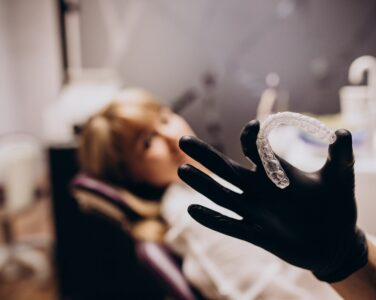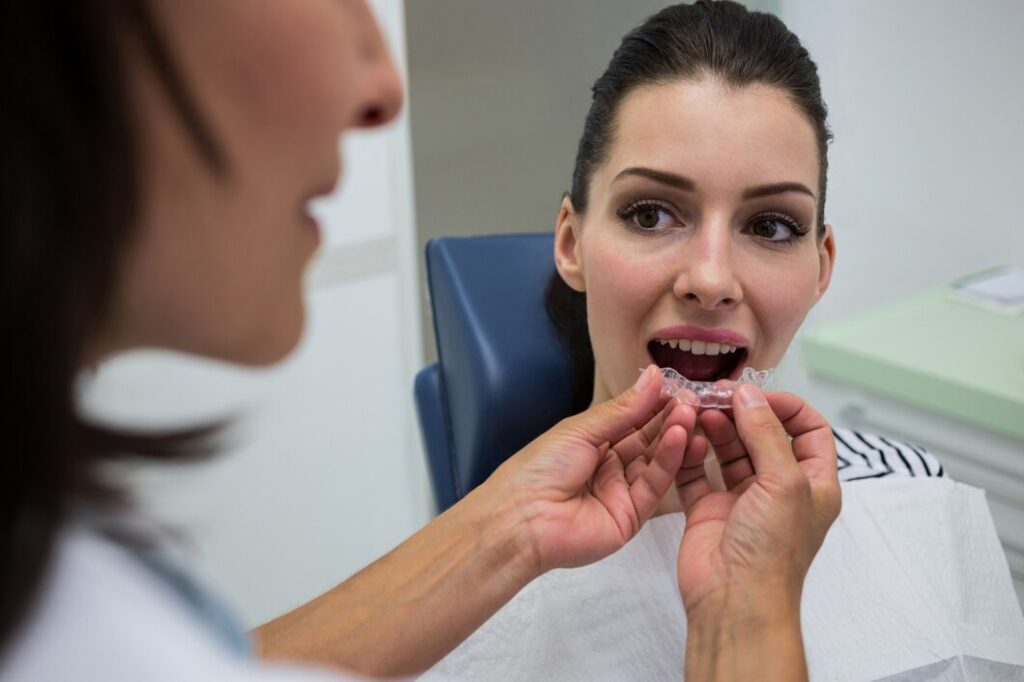Ever wake up with a sore jaw or those persistent headaches that seem to linger throughout the day? If you’ve experienced the discomfort of teeth grinding or jaw clenching, especially during the night, you’re not alone. If you’re wondering how to get relief from them, you’re at the right place. In this blog, we’re unravelling the major difference between two solutions – the occlusal splint dental and the night guard.
Let’s explore these straightforward yet impactful solutions, ensuring you wake up without the aches and pains that make mornings less delightful. So, if you’re curious about putting those morning discomforts to rest, keep reading!
Decoding Occlusal Splint vs Night Guard
When you’re in search of something to ease mouth discomfort, you’ll likely come across two options. It is assumed that both are designed to provide relief, but they have distinct differences. Let’s understand the differences:
How can we define occlusal splints?
An occlusal splint is a removable dental device that covers either the upper or lower teeth. Usually crafted from hard acrylic resin based on an impression of your teeth, these splints are customised in a dental lab. Once made, your dentist will fit and adjust it for you. You’ll be advised when to wear it—whether all day, only at night, or both. These splints help relax your jaw muscles, assist in realigning your jaw and many more that we will discuss further.
What are the different types of occlusal splints dental?
According to Dawson’s classification, occlusal splints can be of three different kinds:
- Permissive splints
Permissive splints let the teeth move freely without any hindrance on the biting surface. They work by adjusting how the teeth come together, preventing interference with the complete seating of the jaw joints and controlling muscle forces. That’s why they’re also known as muscle deprogrammers and are a type of flat-plane appliance. There are two main types of permissive splints: those with contact in the middle of the front teeth (anterior midpoint contact splints) and those with contact on all teeth (full contact splints).
- Non-permissive splints
Occlusal splints dental that restrict the movement of the jaw are known as non-permissive splints. These devices have slopes or dents on the biting surface, limiting the jaw’s motion. They are also called “directive splints” because they guide the jaw into a specific position relative to the upper jaw. The main goal of these splints is to align the jaw joints to a more stable position. There are two types: one is an anterior repositioning splint and the other one is known as a posterior bite plane.
- Pseudo-permissive splints
These splints work differently from permissive splints and constitute two very distinct types, ie. soft splints and hydrostatic splints.
- Hydrostatic Appliance: This device features water-filled chambers on posterior teeth, providing a cushioning effect to redistribute biting forces. These chambers connect to acrylic palatal plates and operate based on Pascal’s Law, which means, using water to balance biting pressure, address malocclusion, and ease temporomandibular joint dysfunction and symptoms related to temporomandibular disorders.
- Soft Rubber Splint: Made of a flexible material (polyvinyl sheet), this appliance is typically worn at night and offers relief within about 6 weeks. Unlike hard splints, soft splints are less likely to cause significant changes to your bite. They are used to minimise symptoms of joint issues or muscle pain, prevent teeth grinding and clenching, and serve as protective devices to be used by athletes.
Benefits of occlusal splints dental for you
The following are the benefits of using occlusal splints:
- Muscle Relaxation: occlusal splints ease tension in the muscles.
- Centric Relations Maintenance: Keeps the jaw in a stable position.
- Diagnostic Aid: Offers valuable information for diagnosis.
- Protection from Bruxism: Safeguards teeth and related structures from grinding.
- Periodontal Ligament Proprioception Mitigation: Lessens sensitivity in the ligaments.
In the discussion of occlusal splints vs night guard, it is time to talk about night guard
What is a night guard?
A night guard is a custom-made plastic piece that looks like a retainer. It can be hard or soft and is worn on either the top or bottom teeth to cover the biting surfaces. Dentists might call it different names like bite splint, dental guard, or nocturnal bite plate, but they all mean the same thing. It’s made to fit your teeth, so it’s comfortable and not too bulky.
Do night guards also have types?
Yes, there are 3 types:
- Soft Night Guard
A soft night guard is crafted from a flexible, rubbery material. It helps reduce the effects of teeth grinding by creating a gentle barrier between the teeth and is typically suggested for those with mild bruxism.
- Hybrid Night Guard
These night guards have a soft rubber interior and a hard acrylic exterior. They serve as a barrier between the teeth, offering comfort on the inside while providing a strong surface against biting. People who grind moderately or heavily are generally advised to use hybrid night guards while sleeping.
- Hard Night Guard
A hard night guard has both inner and outer layers made of acrylic. Due to its exceptional durability, it is often recommended for individuals who grind their teeth heavily.
What are the benefits of using a night guard?
Night guard usually offers the following benefits:
- Prevent Teeth Damage: Teeth grinding can lead to enamel loss, causing over-sensitivity and a night guard can help reduce grinding.
- Prevents Temporomandibular Joint Disorder (TMJ): TMJ dysfunction causes difficulties in chewing, ear and jaw pain, headaches, and possible articular disk damage. Wearing a night guard eases tension in the muscles, preventing the development of TMJ disorders.
- Prevent Chronic Headaches: By reducing teeth grinding, and clenching and alleviating muscle tension, night guards help prevent chronic headaches.
What’s the major difference then?
You might think they are similar but there are some important differences to note. A night guard is meant to stop you from grinding your teeth while sleeping, protecting them from damage. It keeps your teeth apart but doesn’t provide the same vertical support as an occlusal splint dental. An occlusal splint dental helps position your jaw correctly when resting, which isn’t the main goal of a night guard.
Unlike night guards used during sleep, occlusal splints are also worn during the day.
Moreover, an occlusal splint cost is typically between $400 to $800 or above whereas night guards usually vary from $200 to $600 or more. The price depends on factors like where you buy them, the materials used, and any extra features included.
For efficient and reliable occlusal splints and night guards in Perth, Quick Denture Repair is where you should put your trust. They always make sure your dental devices are properly customised and help your dental journey to be the most effective one!


